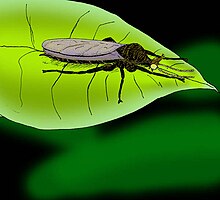Cascoplecia
| Cascoplecia Temporal range:
| |
|---|---|

| |
| holotype fossil | |
| Scientific classification | |
| Domain: | Eukaryota |
| Kingdom: | Animalia |
| Phylum: | Arthropoda |
| Class: | Insecta |
| Order: | Diptera |
| Superfamily: | Bibionoidea |
| Family: | Bibionidae |
| Genus: | †Cascoplecia Poinar, 2010 |
| Species: | †C. insolitis
|
| Binomial name | |
| †Cascoplecia insolitis Poinar, 2010
| |
Cascoplecia insolitis, rarely known as the unicorn fly,type specimen was found in Burmese amber.[1] George Poinar Jr., who described the fossil, placed the genus into a new family Cascopleciidae. One of the defining characteristics of Cascoplecia is the presence of three ocelli raised on an extended, horn-like protuberance. The distinctiveness of the family was questioned by other authors, and the genus has been subsequently transferred to the family Bibionidae.[2][3]

References
- ^ .
- ^ Thomas Pape, Vladimir Blagoderov & Mikhail B. Mostovski. 2011 Order DIPTERA Linnaeus, 1758. In: Zhang, Z.-Q. (Ed.) Animal biodiversity: An outline of higher-level classification and survey of taxonomic richness.
- ^ Li, L.; Skibińska, K.; Krzemiński, W.; Wang, B.; Xiao, C.; Zhang, Q. (2021). "A new March fly Protopenthetrius skartveiti gen. nov. et sp. nov.(Diptera, Bibionidae, Plecinae) from mid-Cretaceous Burmese amber". Cretaceous Research. 104924.
